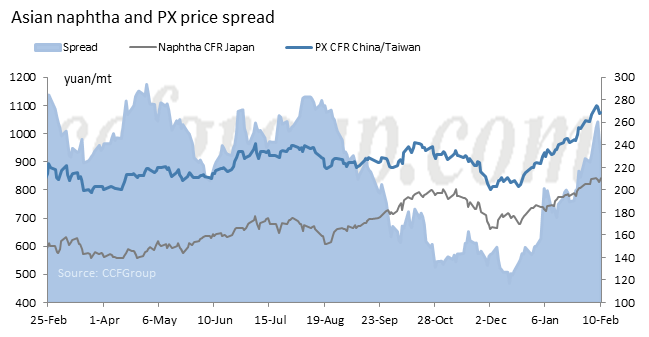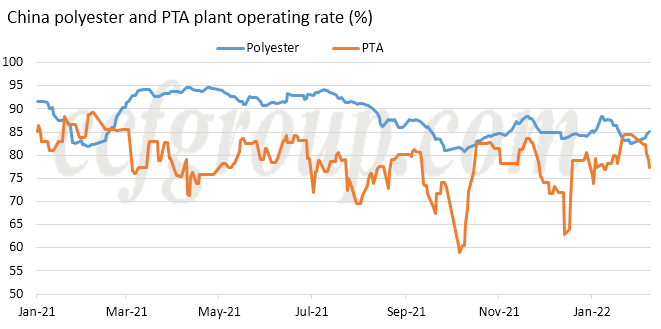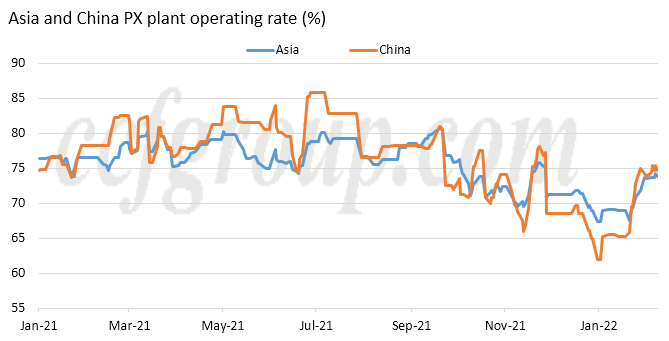PX-naphtha spread recovery and forecast based on supply and demand
PX market trimmed some gains after the rise driven by crude oil since Spring Festival holiday. PX-naphtha spread narrowed in tandem, from high point of $260/mt on Feb 8 to around $230/mt on Feb 10. Then, has the recovery of PXN spread come to an end?

On demand front, Yisheng announced plant operating rate cut or maintenance for 3 PTA lines in the week ending Feb 10. Yisheng New Materials reduced the operating rate of its phase I PTA line to 50% on Feb 9; Yisheng Ningbo shut its 2 million mt/yr PTA line on Feb 10 for maintenance; and Yisheng Dalian planned to shut one 2.25 million mt/yr PTA line on Mar 1 for maintenance. The average operating rate of China domestic PTA plants had dropped by 4 percentage points from 84% before the Spring Festival holiday, to around 80%, while further drop could be capped.
Though crude oil and the feedstock for polyester advanced sharply right back from the holiday, downstream polyester sales ratio was lackluster. It averaged 70% on Fen 7, the first trading day after the holiday, but then declined to around 20% for the rest of the week. Besides from slower recovery of end-use demand, market sentiment was cautious with participants unwilling to raise price. When would the end-use demand could recover need further observation, and it could take place as late as in end-Feb or early Mar.

On supply front, PXN spread was recovering rapidly, and spot supply was tight. Discussions for spot PX were at premium to formula price, equivalent to contract price minus $5/mt or minus $6/mt, hence, spot goods were attractive. Several producers in China, including Sinochem Quanzhou, Sinopec Fujian and Fujia Dahua restart their PX plants. Saudi’s Rabigh has also restarted its plant, while the operating rate is low. In addition, the problem that Vietnam’s NSPR had been faced with, which was the driving force to PX market prior to the holiday, has been solved, and regular contract supply from NSPR would be available. Moreover, some other plants in China or South Korea raise PX plant operating rates, and some outside China plan to further increase the run rates in Mar.

As a result, it is estimated that China and Asia PX plant operating rate could increase by 4 percentage points as of mid-Mar. However, it could reduce afterwards, with Sinopec HRCC and Sinopec Yangtze to shut their PX plants for scheduled maintenance starting from mid-Mar.
With the recovery in PXN spread, PX supply shortage gets relieved. With the trading laycan rolling to Apr goods, tight supply and demand situation may further alleviated, which is also reflected in the backwardated structure. However, before the startup of new PX capacity from Shenghong and ZPC running at full swing, China PX supply and demand could be broadly balanced. PXN spread may keep strong with some PTA plants entering to buy spot goods sometimes.
In the backdrop of largely balanced supply and demand, with the expectation of PX plant operating rate hike and squeeze in PTA profits, any accidental PX or PTA plant shutdown could cause increasing volatility in PX price. Yet PX price is also affected by crude oil. Unless something unexpected happens, PXN spread is forest to hover in the range of $200-250/mt.
- Top keywords
- Cotton Price
- Cotton Futures Price
- Cotton Futures
- CZCE
- PTA Futures Price
- Chemical Fiber
- Polyester Prices
- Wool price
- PTA Futures
- Shengze Silk
- China
- Yarn Price
- price
- China Textile City
- Fibre Price
- Benzene Price
- Cotton
- Index
- Cotton Index
- PTA
- fabric price
- NYMEX
- Top 10
- textile industry
- Spot Cotton
- Cotton Yarn
- Polyester Price
- Futures
- PTA Price
- cotton yarn price

